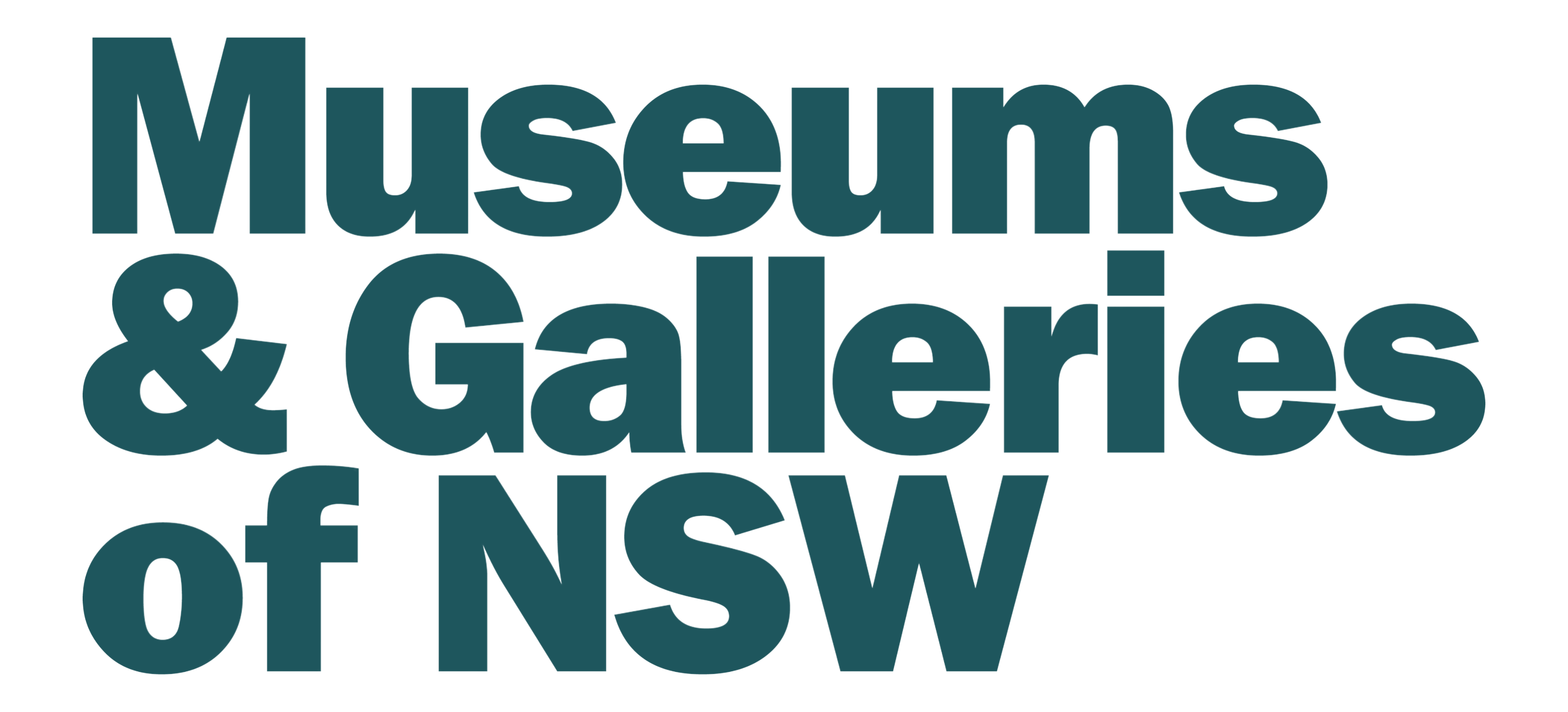Legal requirements: Insurance and compliance
Here is a list of legal requirements and legislative acts that apply to not-for-profit, non-government museums, art galleries and Aboriginal keeping places in NSW.
According to the National Standards for Australian Museums and Galleries, v.4, 2014 (p 21):
Laws and regulations vary from state to state, while different by-laws may apply in different local government jurisdictions. In the museum context, areas of activity that have legal implications include:
- advertising and publishing (in addition to copyright, legal issues could include moral rights and defamation)
- building works
- classification of content of exhibitions and other programs
- financial management
- handling or storing dangerous goods, hazardous materials, or firearms
- property insurance
- public liability
- managing heritage buildings and building fabric
- managing staff
- managing volunteers
- market research
- occupational health and safety (WHS)
- operation of steam boilers and pressure vessels
- operation of vehicles, including forklifts
- protection of built and moveable cultural heritage
- records management
- sales and/or service of food and/or liquor
- urban planning
- working with children
Specific areas of licensing are as follows
Copyright
The legal requirements for copyright licensing are set out in the Copyright Act 1968. Information can be downloaded from the Australia Copyright Council.
See: http://www.copyright.org.au/acc_prod/ACC/Information_Sheets/Ownership_of_Copyright.aspx
Health, workplace, or environmental regulations
Safework Australia and Work Cover NSW protect the occupational health and safety of employees and volunteers within the workplace.
See: https://www.safework.nsw.gov.au/legal-obligations/volunteering
Zoning or building code requirements
The National Construction Code requires certain standards of building compliance in existing buildings if they are to be upgraded or new building work is proposed.
Access
Disability Discrimination Act (DDA) 1992 requirements for equitable access.
See: https://www.legislation.gov.au/Details/C2018C00125
Heritage Act
Heritage Act 1977 applies to buildings listed on the State Heritage Register. It requires the building owner to apply for a development application (DA) for any works that include demolition, damage or alterations to the building fabric.
See: https://legislation.nsw.gov.au/view/html/inforce/current/act-1977-136
Environmental Planning and Assessment
The Environmental Planning & Assessment Act 1979 (EP&A Act) regulates land use planning and development in NSW. Under this Act a Local Council Development Application 7 and/or Heritage Impact Assessment may be required for works to a local heritage item.
When a building is also a heritage item, there are a number of technical and advisory publications by the Heritage Division of the Office of Environment and Heritage (OEH) pertaining to change of use for heritage buildings.
See: http://www.environment.nsw.gov.au/Heritage/publications/index.htm
Fire Access and Safety
The Fire Access and Services Advisory Panel (FASAP) is the Heritage Council of NSW’s expert technical panel which provides advice on upgrading heritage buildings to satisfy legal standards required for fire safety, access for people with disabilities and services in ways that will not diminish their heritage significance.
See: http://www.environment.nsw.gov.au/Heritage/conservation/fireaccessservices.htm
Insurance
Public liability insurance is essential. All collecting organisations should have it, without exception. If an organisation invites the public to its premises it must protect both itself and its invitees. It is not a legal obligation, but a social obligation.
Insurance to cover volunteers for personal injury is highly recommended. Most insurance agencies cater for public liability and personal injury. Museums Australia provides a range of insurance tailored for museums through Arthur Gallagher.
See: http://www.museumsaustralia.org.au/admin/email_templates_archive_message.php?id=1510
Working with Children
The Working with Children Check is a prerequisite for paid and unpaid child-related work. Under Part 2, section 6 of the Child Protection (Working With Children) Act 2012, child-related work is defined as work in a specific, child-related role or face-to-face contact with children in a child-related sector. Additional roles are identified in the Child Protection (Working with Children) Regulation 2013.
Collection and object-related compliance
There are a number of relevant national and state legislation and museum standards relating to museums that govern the acceptance and ownership of objects. These include, but are not limited to:
- Museums Australia Code of Ethics, 1984, revised 1999
http://www.museumsaustralia.org.au/userfiles/file/Governance/maethics.pdf - International Council of Museums Code of Ethics for Museums (ICOM), 2003
http://icom.museum/fileadmin/user_upload/pdf/Codes/code_ethics2013_eng.pdf - Burra Charter of ICOMOS Australia, 1999
http://australia.icomos.org/publications/charters/ - Convention on International Trade in Endangered Species (CITES), 1973
https://www.cites.org/ - Australian Movable Cultural Heritage Prohibited Exports Register
http://arts.gov.au/movable/export/register - National Cultural Heritage Control List (NCHL)
http://arts.gov.au/movable/export/list - New South Wales Heritage Act, 1977
http://www.austlii.edu.au/au/legis/nsw/consol_act/ha197786/ - New South Wales National Parks and Wildlife Act, 1974
http://www.austlii.edu.au/au/legis/nsw/consol_act/npawa1974247/ - New South Wales Environment and Planning Assessment Act, 1979
http://www.austlii.edu.au/au/legis/nsw/consol_act/epaaa1979389/ - New South Wales Firearms Act, 1996
http://www.legislation.nsw.gov.au/fullhtml/inforce/act+46+1996+FIRST+0+N? - New South Wales Firearms Legislation 2006
http://www.legislation.nsw.gov.au/fullhtml/inforce/subordleg+512+2006+FIRST+0+N? - Continuous Cultures, Ongoing Responsibilities: Principles and Guidelines for Australian Museums working with Aboriginal and Torres Strait Islander Cultural Heritage, 2005
http://www.nma.gov.au/__data/assets/pdf_file/0020/3296/ccor_final_feb_05.pdf - Privacy Act, 1988; and Amendments, 2014
https://www.comlaw.gov.au/Details/C2015C00534 - Protection of Moveable Cultural Heritage (PMCH) Act, 1986
https://www.comlaw.gov.au/Details/C2015C00479 - Protection of Moveable Cultural Heritage Regulations, 1987
https://www.comlaw.gov.au/Details/F2004C00105 - UNESCO Convention for the Safeguarding of the Intangible Cultural Heritage, 2003
http://portal.unesco.org/en/ev.php-URL_ID=17716&URL_DO=DO_TOPIC&URL_SECTION=201.html - UNESCO Convention on the Protection of the World Cultural and Natural Heritage, 1972
http://whc.unesco.org/en/conventiontext/ - UNESCO Convention on the Means of Prohibiting and Preventing the Illicit Import, Export and Transfer of Ownership of Cultural Property, 1970
http://portal.unesco.org/en/ev.php-URL_ID=13039&URL_DO=DO_TOPIC&URL_SECTION=201.html
This resource was prepared with information from the following sources:
- National Standards for Australian Museums and Galleries, v.4, 2014, available from M&G NSW website
http://mgnsw.org.au/sector/support/standards-program/ - Shane Simpson‘s Collection Law
http://simpsons.com.au/online-resources/online-library/museums-galleries/ - Museums Australia Code of Ethics for Art, History and Science Museums 1999
http://www.museumsaustralia.org.au/userfiles/file/Governance/maethics.pdf - Compliance for not-for-profit organisations
https://www.ourcommunity.com.au/management/view_help_sheet.do?articleid=757
While all care has been taken to ensure information is accurate at the time of publication, all information in this resource is intended as a guide only. You should obtain professional advice if you have any specific concerns.
